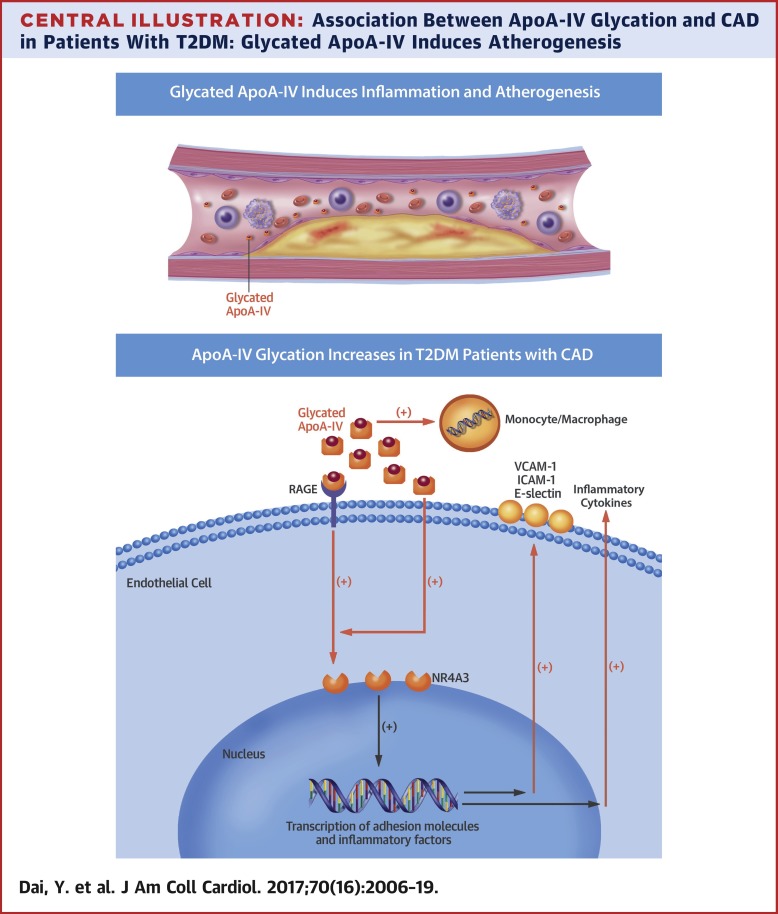当前位置:
X-MOL 学术
›
J. Am. Coll. Cardiol.
›
论文详情
Our official English website, www.x-mol.net, welcomes your feedback! (Note: you will need to create a separate account there.)
Glycated Apolipoprotein A-IV Induces Atherogenesis in Patients With CAD in Type 2 Diabetes
Journal of the American College of Cardiology ( IF 24.0 ) Pub Date : 2017-10-01 , DOI: 10.1016/j.jacc.2017.08.053 Yang Dai , Ying Shen , Qing Run Li , Feng Hua Ding , Xiao Qun Wang , Hong Juan Liu , Xiao Xiang Yan , Ling Jie Wang , Ke Yang , Hai Bo Wang , Qiu Jing Chen , Wei Feng Shen , Rui Yan Zhang , Lin Lu
Journal of the American College of Cardiology ( IF 24.0 ) Pub Date : 2017-10-01 , DOI: 10.1016/j.jacc.2017.08.053 Yang Dai , Ying Shen , Qing Run Li , Feng Hua Ding , Xiao Qun Wang , Hong Juan Liu , Xiao Xiang Yan , Ling Jie Wang , Ke Yang , Hai Bo Wang , Qiu Jing Chen , Wei Feng Shen , Rui Yan Zhang , Lin Lu

|
BACKGROUND
Nonenzymatic glycation of apolipoproteins plays a role in the pathogenesis of the vascular complications of diabetes. OBJECTIVES
This study investigated whether apolipoprotein (apo) A-IV was glycated in patients with type 2 diabetes mellitus (T2DM) and whether apoA-IV glycation was related to coronary artery disease (CAD). The study also determined the biological effects of glycated apoA-IV. METHODS
The authors consecutively enrolled 204 patients with T2DM without CAD (Group I), 515 patients with T2DM with CAD (Group II), and 176 healthy subjects (control group) in this study. ApoA-IV was precipitated from ultracentrifugally isolated high-density lipoprotein, and its glycation level was determined based on Western blotting densitometry (relative intensity of apoA-IV glycation). ApoA-IV NƐ-(carboxylmethyl) lysine (CML) modification sites were identified by mass spectrometry in 37 control subjects, 63 patients in Group I, and 138 patients in Group II. Saline or glycated apoA-IV (g-apoA-IV) generated by glyoxal culture was injected into apoE-/- mice to evaluate atherogenesis, and was also used for the cell experiments. RESULTS
The relative intensity and the abundance of apoA-IV glycation were associated with the presence and severity of CAD in patients with T2DM (all p < 0.05). The experiments showed that g-apoA-IV induced proinflammatory reactions in vitro and promoted atherogenesis in apoE-/- mice through the nuclear receptor NR4A3. G-apoA-IV with mutations (K-A) at high-frequency glycation sites exhibited more weakened proinflammatory and atherogenic effects than did g-apoA-IV both in vitro and in vivo. CONCLUSIONS
ApoA-IV glycation is associated with CAD severity in patients with T2DM, and g-apoA-IV induces atherogenesis through NR4A3 in apoE-/- mice.
中文翻译:

糖化载脂蛋白 A-IV 诱导 2 型糖尿病 CAD 患者的动脉粥样硬化
背景载脂蛋白的非酶促糖基化在糖尿病血管并发症的发病机理中起作用。目的 本研究调查了载脂蛋白 (apo) A-IV 在 2 型糖尿病 (T2DM) 患者中是否被糖化,以及 apoA-IV 糖化是否与冠状动脉疾病 (CAD) 相关。该研究还确定了糖化 apoA-IV 的生物学效应。方法 作者在这项研究中连续招募了 204 名无 CAD 的 T2DM 患者(I 组)、515 名患有 CAD 的 T2DM 患者(第二组)和 176 名健康受试者(对照组)。ApoA-IV 是从超速离心分离的高密度脂蛋白中沉淀出来的,其糖化水平基于蛋白质印迹光密度测定法(apoA-IV 糖化的相对强度)确定。ApoA-IV NƐ-(羧甲基)赖氨酸 (CML) 修饰位点通过质谱法在 37 名对照受试者、I 组 63 名患者和 II 组 138 名患者中鉴定。将乙二醛培养产生的盐水或糖化 apoA-IV (g-apoA-IV) 注射到 apoE-/- 小鼠中以评估动脉粥样硬化,也用于细胞实验。结果 apoA-IV 糖基化的相对强度和丰度与 T2DM 患者 CAD 的存在和严重程度相关(所有 p < 0.05)。实验表明,g-apoA-IV 在体外诱导促炎反应,并通过核受体 NR4A3 促进 apoE-/- 小鼠的动脉粥样硬化。在体外和体内,在高频糖化位点具有突变 (KA) 的 G-apoA-IV 表现出比 g-apoA-IV 更弱的促炎和致动脉粥样硬化作用。
更新日期:2017-10-01
中文翻译:

糖化载脂蛋白 A-IV 诱导 2 型糖尿病 CAD 患者的动脉粥样硬化
背景载脂蛋白的非酶促糖基化在糖尿病血管并发症的发病机理中起作用。目的 本研究调查了载脂蛋白 (apo) A-IV 在 2 型糖尿病 (T2DM) 患者中是否被糖化,以及 apoA-IV 糖化是否与冠状动脉疾病 (CAD) 相关。该研究还确定了糖化 apoA-IV 的生物学效应。方法 作者在这项研究中连续招募了 204 名无 CAD 的 T2DM 患者(I 组)、515 名患有 CAD 的 T2DM 患者(第二组)和 176 名健康受试者(对照组)。ApoA-IV 是从超速离心分离的高密度脂蛋白中沉淀出来的,其糖化水平基于蛋白质印迹光密度测定法(apoA-IV 糖化的相对强度)确定。ApoA-IV NƐ-(羧甲基)赖氨酸 (CML) 修饰位点通过质谱法在 37 名对照受试者、I 组 63 名患者和 II 组 138 名患者中鉴定。将乙二醛培养产生的盐水或糖化 apoA-IV (g-apoA-IV) 注射到 apoE-/- 小鼠中以评估动脉粥样硬化,也用于细胞实验。结果 apoA-IV 糖基化的相对强度和丰度与 T2DM 患者 CAD 的存在和严重程度相关(所有 p < 0.05)。实验表明,g-apoA-IV 在体外诱导促炎反应,并通过核受体 NR4A3 促进 apoE-/- 小鼠的动脉粥样硬化。在体外和体内,在高频糖化位点具有突变 (KA) 的 G-apoA-IV 表现出比 g-apoA-IV 更弱的促炎和致动脉粥样硬化作用。



























 京公网安备 11010802027423号
京公网安备 11010802027423号